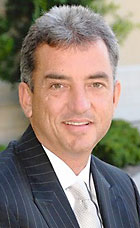Visit Florida - Reinvented
Posted 10/8/2012

Four years ago, Visit Florida was teetering. Legislators, facing budgetary pressures and irritated over a decision to use an out-of-state call center, tried to slash the organization’s budget. The cuts were restored through a veto by then-Gov. Charlie Crist.
Meanwhile, Visit Florida grew concerned that it couldn’t compete with Google in efforts to reach customers online. For instance, Visit Florida used to charge businesses to be listed on its website. With Google moving into the travel arena, offering businesses greater bang for their buck through targeted ads, Visit Florida’s online potency could be diminished.
When Chris Thompson became CEO in 2009 after a stint as COO, he decided to focus on repairing the agency’s relationship with the Legislature and re-examining its mission. “How do we stay relevant in a changing world?” Thompson asked.
|
UPDATE: Late September 2012, Brand USA announced the appointment of Chris Thompson to president and CEO of the public private partnership responsible for spearheading the United States’ first nationally coordinated tourism marketing effort. Currently, Thompson is working with the board of directors of VISIT FLORIDA to ensure a smooth transition from his current role to Brand USA. An official start date will be announced soon. |
A turnaround began last year, just before Gov. Rick Scott and the Legislature considered folding Visit Florida into another state agency as part of a consolidation effort. Scott was persuaded to keep Visit Florida’s public-private partnership structure intact. He ultimately approved a 55% increase in the state’s portion of the organization’s budget for this fiscal year, helping Visit Florida target international travelers, who stay longer and spend more. The agency hopes to bolster travel from the U.K., which was Florida’s biggest international market until Brazil surpassed it last year. In response, Visit Florida has increased ad spending in the U.K. by $1.6 million — nearly quadruple what it was the year before.
The re-emphasis on attracting British tourists is a far cry from 2009, when Visit Florida closed its U.K. office to save money. (Visit Florida is also more than doubling its advertising spending in Canada and South America.)
Visit Florida isn’t ignoring domestic travelers, still the lifeblood of the tourism industry, comprising 86% of Florida’s visitors. The organization plans to spend $40 million more on domestic travelers this year. Prime among the targets is Texas, which has good air service and has weathered the recession relatively well.
With tourism numbers and revenue climbing, Scott is now one of Visit Florida’s biggest cheerleaders. He routinely touts its “return on investment.” For every dollar Visit Florida spends on marketing, it generates $258 in tourism spending.
Meanwhile, Visit Florida has expanded its role as an information source for tourists. Business are now listed on the website for free, which has doubled listings and increases the site’s value for travelers. The organization generates more of its own print and online content and has hired two full-time writers. “It won’t be long until we’re generating more rich content about Florida than any of the major consumer travel magazines, any of the major travel trade magazines,” Thompson says.
